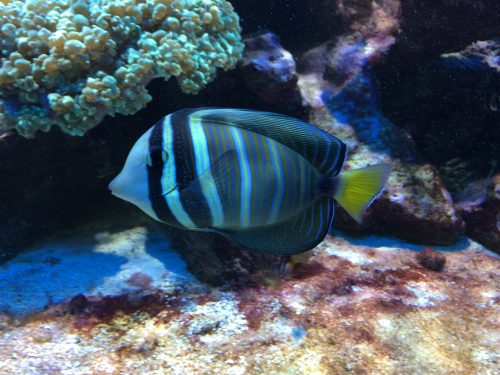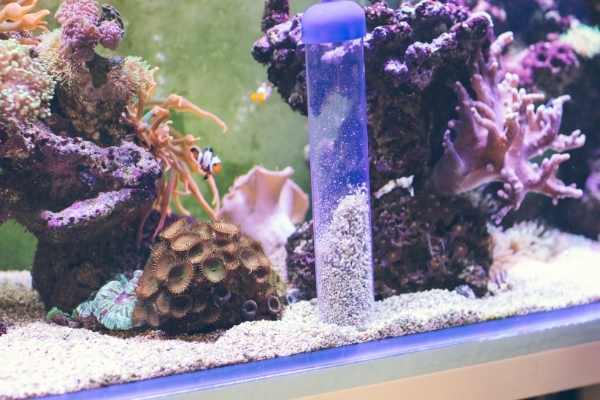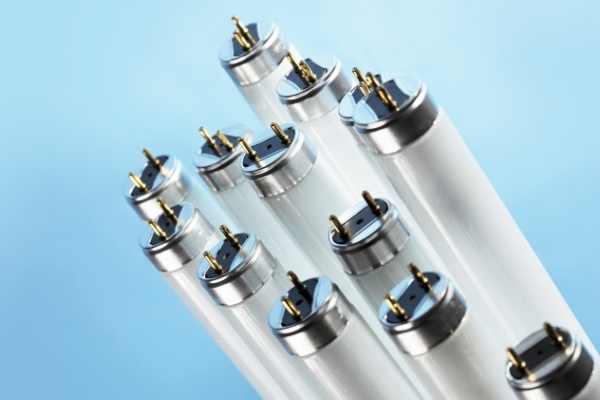[ad_1]
Red Slime Algae is the common name for an aquarium troublemaker otherwise known as red cyanobacteria. Since the term cyanobacteria sound like either a bizarre Crayola Crayon color or the bacterial strain in a Michael Crichton novel (how’s that for a dated reference), the more popular term red slime algae tend to fit quite well.
It does have a reddish tint (which can appear on the brown or purple ends of the light spectrum, depending on the lighting in your tank and thickness of the growth) and a slimy look about it, which is likely how it got the name.
If the shoe fits, wear it.
Red slime algae are universally hated by saltwater aquarists, mostly because it:
- Grows even though it is unwanted
- Can sometimes be difficult to control
- Creates extra work
- Is generally thought to be ugly
- Seen as a sign of an ‘out-of-control’ tank
How’s that for a resume?

Red slime algae affect many tanks–this is a prominent reef display at a public aquarium
However, unlike the dreaded saltwater ich, marine velvet, rapid tissue necrosis, old tank syndrome, and other aquarium problems that have been known to kill or even wipe out an entire system, all red slime algae are known for is…well…being ugly and slimy.
With that said, a red slime algae outbreak in your tank is nothing to laugh about.
What causes a red slime algae outbreak?
I’m not sure that we, as a saltwater aquarium or scientific community, have figured out exactly what the recipe is for a red slime algae outbreak, but here are a few important elements that see to show up time and time again:
Age of the aquarium
No, not the Age of Aquarius, but the age of your aquarium. The outbreaks I have encountered mostly occur in tanks that are about 0-6 months in age. I have encountered this personally, as well as someone providing advice to people who have emailed me over the years because of this blog.
My hypothesis is that red slime algae thrive in that new tank environment. Over time, the inhabitants (micro and macrofauna) of an established saltwater aquarium help to keep the red slime algae in check—but in the early stages of saltwater aquarium maturity, red slime algae seems to get a foothold much more easily.
Three things cyanobacteria need to grow
Red slime algae is a photosynthetic organism that needs three things to grow:
- light for photosynthesis
- nutrients to fuel growth
- a structure on which to grow.
It tends to get a foothold in an area of the tank with low flow.
11 Ways to Fight Red Slime Algae
If you want to combat the growth of red slime algae in your tank, you have to hit it where it hurts:
- Light
- Nutrients
- Structure
- Kill it chemically
1) Perform partial water changes
Nitrates, phosphates, and silicates are a waste product in your aquarium water that can act as a fertilizer for red slime algae and fuel its growth. To fight red slime algae, you should first take your fight to the water quality and remove nitrates, phosphates, or silicates. The easiest way to do this is with partial water changes. While you do your water changes, give the red slime algae a blast with a turkey baster or a powerhead. You want to dislodge it from the rocks and physically remove it from the aquarium water. This is a pain. It feels like thankless grunt work, but it is a necessary step to regain control of your tank.
2) Check your food labels and research them online or wash your food
What are you feeding your fish/corals? It is quite possible you are feeding them something that is naturally high in phosphates or silicates, which is polluting your water. It is also possible that you are feeding your fish and corals too much. While you are battling with the red slime algae, reduce the amount of food you add to your tank. Check the ingredients, and search online to see if it contains phosphates or silicates. If you are using frozen foods, like frozen mysid shrimp or brine shrimp, rinse the cubes in tap water, with a strainer, rather than putting the entire cube contents in your tank.
3) Reduce the amount of food you are feeding your tank
Let’s face it, you’re in this hobby for a reason–you like to watch the fish, corals, and other invertebrates in your tank. What’s an interesting behavior to watch? How about watching them eat? Because we love to watch the animals in our tanks eat, we also love to feed them and we probably feed them too much. If you’re battling red slime algae, cut back the amount of food you’re adding to the tank. Any leftover food is just fueling the growth of problem algae.
4) Add a chemical media or media reactor to combat cyanobacteria
If phosphates, silicates, and nitrates remain a problem, you can add a chemical media like GFO or biopellets to help.
5) Keep the water flow high
Red slime algae lights to get a foothold on your tank starting in the areas of low flow. One way to help prevent it from getting started and to keep the pressure on it once it has started to grow in your tank is to keep the water flow up. Move powerheads in your tank to eliminate dead spots. Add a powerhead or two to increases the water flow. Keep the water moving, to keep red slime algae in line.
6) Change old light bulbs (if you have them)
The first thing to look for, from a lighting perspective, is whether you have fresh bulbs. One thing I’ve seen happen a lot is that while your tank has only been up and running for about 3 months, the lights you have on your tank were given to you by a friend or neighbor and are of unknown origin and age.
As aquarium light bulbs get older, the light spectrum shifts towards the red side, which can lead to the growth of problem algae, like red slime algae.
Sometimes, changing the lightbulb can be enough to correct the problem, if things are otherwise stable.
Make sure to keep good records of when you change your light bulbs and schedule a reminder so that you won’t forget. Of course, you don’t need to do this for quite some time if you buy LED lights.
7) Reduce light
As mentioned earlier, red slime algae need light to grow, so in certain circumstances, you may want to shut off or reduce the light over your tank for a couple of days while you wage war on the red slime algae invader.
Adjusting the light over your tank to combat the red slime algae can be a tricky endeavor if you have other (more important) photosynthetic organisms in your tank, like corals. But, for the most part, if your corals are otherwise healthy, you can adjust the lights for a few days to try to get a jump-start on your red slime algae clean up.
8) Keep filter media clean
If you have a mechanical filter, like a filter sock inside the sump or a pre-filter sponge on the intake of your return pump, be sure to keep it free of debris, detritus, and leftover food. In one way, that’s a sign that the filter is working, on the other hand, any matter that is decaying on that sponge is being blown back into your tank and could be causing nutrient levels to rise.
9) Maintain the proper pH
Keeping your water parameters in line, especially pH, can help you fight red slime algae. Cyanobacteria outbreaks are often associated with lower pH environments. Keeping a naturally high pH (8.1-8.4) can help create an environment ideally suited for your corals and less ideally suited for the red slime.
10) Time
Some of the most dedicated hobbyists who stay on top of things will email me saying, I’m doing everything you said, and I am still having problems.
I wish I had a perfect answer for this—and some science to back it up—but what I usually say in that instance is to just keep with it. Time and tank maturity are factors. I’m not sure exactly what happens to turn the cyanobacteria imbalance into balance, but I can tell you that eventually, it happens.
One day, you win the battle and the red slime algae fade away. So stay on it, stay positive, and don’t let up.
11) Chemical Additives
Two chemical additives to great red cyanobacteria are Chemiclean and Red Cyano Rx. These products do a great job of getting rid of red cyanobacteria in just a matter of days. If you are going to use them, increase the oxygen flow in your tank with an air pump or more flow, because these chemicals will make the oxygen level in your tank go down. You will also want to turn your protein skimmer off.
What is chemiclean?
A product from Boyd enterprises that cleans red, black, blue-green, and methane (bubble) producing cyanobacteria in marine aquariums.
It is completely safe for all fish, corals, invertebrates, and nitrifying bacteria in reef systems. It’s simple, quick, and easy to use. Chemiclean works within 48 hours oxidizing trapped organic sludge and promotes an ideal enzyme balance. Chemiclean will clean stains from red cyanobacteria in aquariums.
The only thing that isn’t safe is the possible drop in oxygen. So be sure to increase those levels to help keep your fish safe.
For more information, you may want to check out these videos:
This is how Reefbum fought his red slime algae:
[ad_2]
Source link



